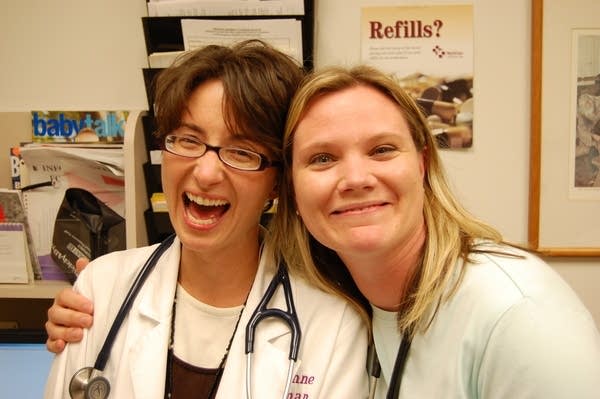Doctor shortage in rural Minnesota reaches crisis
Go Deeper.
Create an account or log in to save stories.
Like this?
Thanks for liking this story! We have added it to a list of your favorite stories.

If you're looking for a family doctor in Bemidji, you'll probably have a tough time. Even though the town's population is growing, there are fewer family practitioners here than there were five years ago.
That's why Dr. Suzie Human is in such high demand at Bemidji's MeritCare Clinic.
When Human moved to Bemidji six years ago, there were 13 family practitioners at the clinic. By this summer, they'll be down to eight.
The clinic is also short of specialists in internal medicine and pediatrics. The clinic has been trying to fill nearly a dozen physician slots for several years, with little luck.
Turn Up Your Support
MPR News helps you turn down the noise and build shared understanding. Turn up your support for this public resource and keep trusted journalism accessible to all.

The shortage means more people who are sick turn to the emergency room, and that's expensive.
Patients sometimes wait up to 15 months just for a physical exam. Human says the shortage means she's had to learn to say no.
"We have people coming in all the time, and there is no family practitioner available," said Human. "Every single day I have people saying, 'Can I see you at the clinic? Can you take on my family?' And every single day I have to say I can't take patients at this time."
The shortage of rural doctors is a national trend. Medical students are strapped with huge debt.
It costs close to $200,000 to attend medical schools in Minnesota. Students can often pay that debt off more quickly by working in metropolitan communities, where the pay and work hours are better.
"Every single day I have to say, I can't take patients at this time."
Medical students are increasingly shunning family practice for the same reasons.
A study in the Journal of the American Medical Association shows that only 2 percent of medical students are going into family practice.
Instead, they're heading to more lucrative specialties like cardiology or anesthesiology, where they can earn three or more times what a family doctor does.
The shortage puts pressure on practitioners in rural communities. Unlike specialists, family doctors see patients for all their health needs, from cradle to grave.
Dr. Suzie Human works long hours and spends more time on call. She says she loves being a family doctor, but she sometimes doesn't see her kids for days at a time.
"No one wants our job. It's a tough job," Human said. "We get torn between delivering babies and being in the clinic, and being in the hospital overnight, and going to the nursing homes. It's not the job that a lot of people want anymore."
The competition for attracting doctors to rural Minnesota is fierce. Many hospitals and clinics have recruiters. They offer tens of thousands of dollars in bonuses. Some help with paying student loans or offer other perks.

"We're starting to recruit or create data bases of students interested in primary care as early as high school, and following up with them on a regular basis," said Dr. Bob Rutka, vice president for medical affairs at North Country Health Services in Bemidji. "There are other communities that are actually paying for the entire cost of a student's medical education."
Rutka says that's happening in Marshall, Minn., but not all communities can afford it.
There are broader efforts to get more doctors outstate.
The University of Minnesota Medical School's Duluth campus tries to attract rural med students who are likely to prefer a rural lifestyle. Students there are required to spend time working with doctors in rural facilities.
The state of Minnesota has a number of loan forgiveness programs to encourage medical school graduates to practice in rural areas.
For example, med students can receive $20,000 annually for up to four years through the Minnesota Department of Health's Rural Physician Loan Forgiveness Program. Recipients must commit to working at least three years in a rural community.
With lots of talk about health care reform, hospital administrators hope any change includes new incentives for doctors practicing in rural communities -- things like loan write-offs and higher pay for family doctors. Many believe the U.S. also needs more medical schools.
But it's not just family practitioners who are in high demand, according to Bonnie Erickson, interim CEO of Falls Memorial Hospital in International Falls. She says the community searched nearly five years for a general surgeon before they found one willing to move there.
Erickson says health administrators in International Falls are always in recruitment mode. They begin planning for replacing physicians and mental health professionals long before they actually retire.
But the community's geographic isolation, limited economy and lack of amenities makes it tough.
"To get them to rural areas, you have to almost have them be looking at hunting, fishing, outdoor types of interests," said Erickson. "Also there's their spouse. If you get the physician, what does the spouse do if they're a professional and you don't have a job for them? That's one of the big issues."
Observers say the need for more doctors in rural communities is becoming more urgent. The number of Minnesotans over age 65 was expected to increase nearly 60 percent between 2000 and 2020.
Those older patients will put a much higher demand on health care services.
Dear reader,
Political debates with family or friends can get heated. But what if there was a way to handle them better?
You can learn how to have civil political conversations with our new e-book!
Download our free e-book, Talking Sense: Have Hard Political Conversations, Better, and learn how to talk without the tension.





